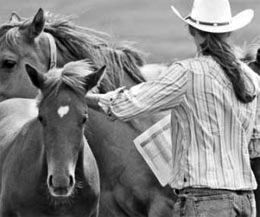- News
- Horse Racing
- Racing Preview
- AQHA Racing Challenge
- Breeding
- Sales
- Quick Stakes Results
- Detail Race Results
- Qualifiers
- Leader Board
- Leading Sires
- Videos
- Auction Leaders
- Q-Racing
Streaming Video

AMARILLO, TX–OCTOBER 13, 2024–Following recent Equine Infectious Anemia (EIA) positives found in racing American Quarter Horses, Oklahoma, Colorado, New Mexico and Texas have announced updated requirements.
The Oklahoma Quarter Horse Racing Association announced that beginning October 13, Will Rogers Downs will require a negative Coggins test dated within 60 days of arrival for any horse arriving from out of state.
In addition, Bally's Arapahoe Park released updated requirements that stated, moving forward from October 9, 2024, until the end of the meet, November 10, 2024, all horses, including pony horses, originating from outside the state of Colorado are required to have a negative Equine Infectious Anemia (Coggins) test that is within 10 days of entry to Bally’s Arapahoe Park Racetrack. Both AGID and ELISA tests are acceptable.
Additionally, a Certificate of Veterinary Inspection (Health Certificate) performed by an accredited veterinarian that is within ten days of entry to Bally’s Arapahoe Racetrack is required. All Quarter Horses arriving from outside the state of Colorado are required to have a negative Equine Piroplasmosis test within 30 days of entry to Bally’s Arapahoe Park Racetrack."
On October 4, the New Mexico Racing Commission released a mandate related to Equine Infectious Anemia.
Signed by Ismael "Izzy" Trejo, the executive director of the NMRC, it reads: Due to the unfortunate and troubling increased instances of the viral Equine Infectious Anemia (EIA) disease being diagnosed in racehorses, the State of New Mexico Racing Commission (NMRC), together with the State of New Mexico Livestock Board, announce the following:
Effective Friday, October 11, 2024, it is mandatory that all horses shipping into either the Downs at Albuquerque or Zia Park must have proof of a negative Coggins test drawn within the previous thirty (30) days in order to gain entry.
Due to the detection of cases of EIA in racehorses housed on grounds and facilities under the regulatory jurisdiction of the NMRC, it is strongly recommended all licensees of horses currently being housed at such locations immediately contact their veterinarians to get an updated Coggins test for all such animals and retain all the paperwork showing negative test results.
The procedures are necessary to protect the health and safety of the equine athletes which are the foundation of New Mexico's horseracing industry. The NMRC thanks its licensees for taking this matter seriously and for their cooperation and compliance.
Earlier in the month, several racehorses tested positive for Equine Infectious Anemia (EIA) at Lone Star Park at Grand Prairie, and six were euthanized on by a private veterinarian following confirmation by the Texas Animal Health Commission (TAHC).
"To protect the safety of all racing participants, I have directed a quarantine of the impacted racehorses to their stabling area and had them removed from live race cards," said Amy F. Cook, executive director of the Texas Racing Commission. "We have implemented safety protocols in coordination with the Texas Animal Health Commission and will allow horses to join future race cards once they receive a negative test."
Texas Racing Commission regulators are working closely with TAHC personnel, Lone Star Park’s corporate management, and impacted licensees of the agency to mitigate the likelihood of a broader outbreak and protect the horses participating in Lone Star Park’s ongoing Quarter Horse meet.
"EIA is spread through blood contact, which can be easily prevented," said Steve Bond, D.V.M., the Racing Commission’s chief state veterinarian. "The health, safety and welfare of racing animals is one of our primary concerns from our regulatory perspective."
According to a TAHC fact sheet, "Equine infectious anemia (EIA) is an incurable, infectious disease caused by a virus that affects members of the Equidae family, such as horses, ponies, zebras, mules, and donkeys. EIA is found widely throughout the world. There is no evidence that EIA is a threat to human health." This fact sheet is available for those who care for horses: Bio Security Guide: Keeping Your Horses Healthy.
"Texas Animal Health Commission (TAHC) officials confirmed equine infectious anemia (EIA) in six horses in Dallas County October 1, 2024," said a TAHC spokesperson. "TAHC staff are working closely with horse owners and other stakeholders to ensure TAHC requirements are met. This is an ongoing disease investigation, and potentially exposed horse owners have been notified and investigation protocols are underway."
The Texas Racing Commission has opened an investigation into the source of the infections.
The California Horse Racing Board earlier this week released an advisory regarding the euthanasia of seven horses following positive tests for EIA.
**************************
The American Quarter Horse Association is committed to protecting the welfare of the American Quarter Horse on and off the racetrack.
As part of this endeavor, the Association strongly supports actions from sanctioned racing groups and other authorities that protect the health and welfare of the American Quarter Horse at racing events. AQHA works closely with racing authorities to uphold the highest standards of welfare and safety and supports all measures to protect both the horse and the industry from isolated actions that do not uphold the highest standards of protection for the horse and for the industry.
AQHA condemns inhumane treatment of the American Quarter Horse and actions that violate the Association’s mission statement and rules that govern the membership.
AQHA is dedicated to adhering to the Association’s mission statement, which in part ensures the American Quarter Horse is treated humanely, with dignity, respect and compassion at all times.
Please use the Equine Disease Communication Center resource for more information.

 Newsletters
Newsletters Facebook
Facebook